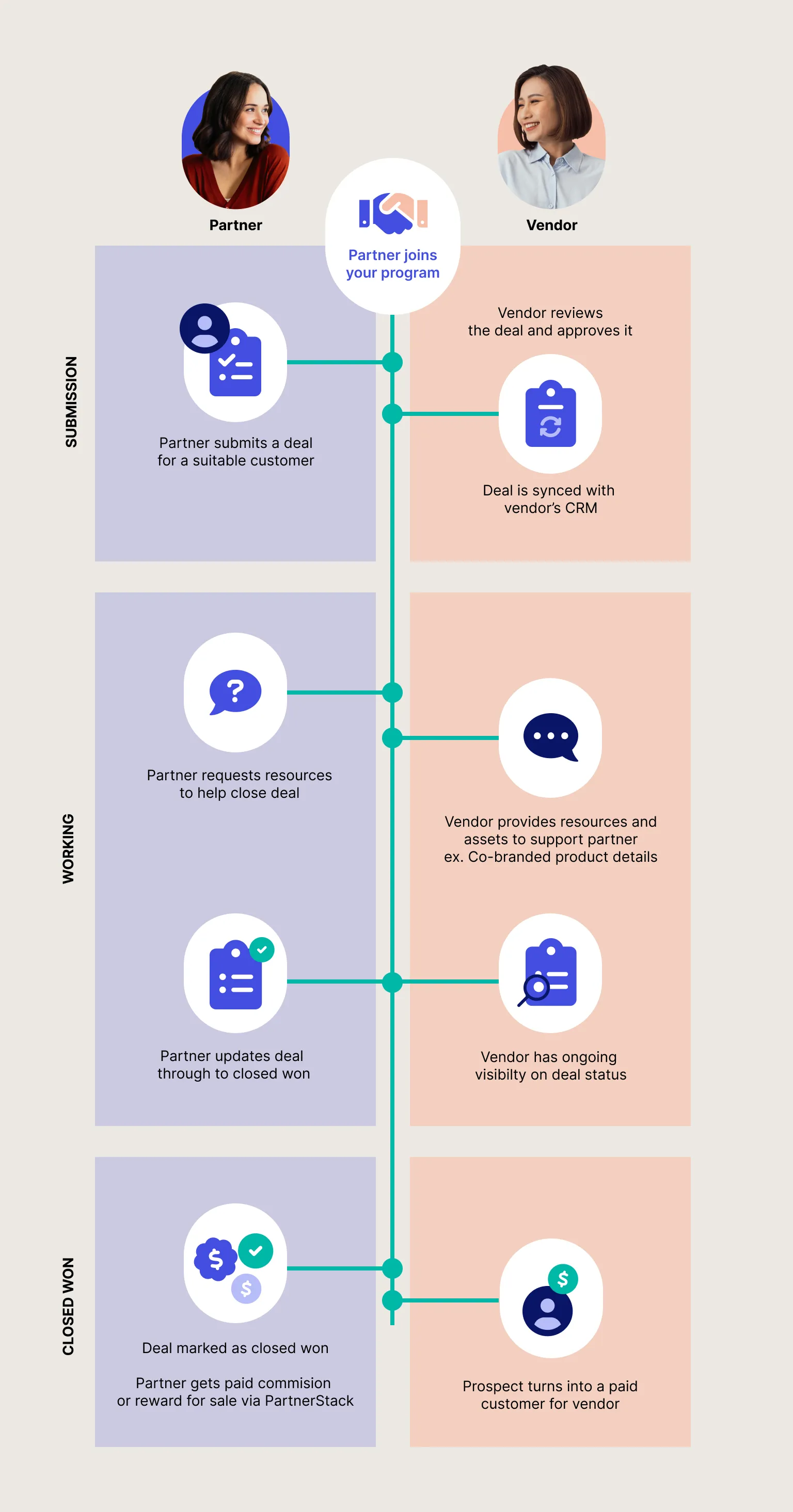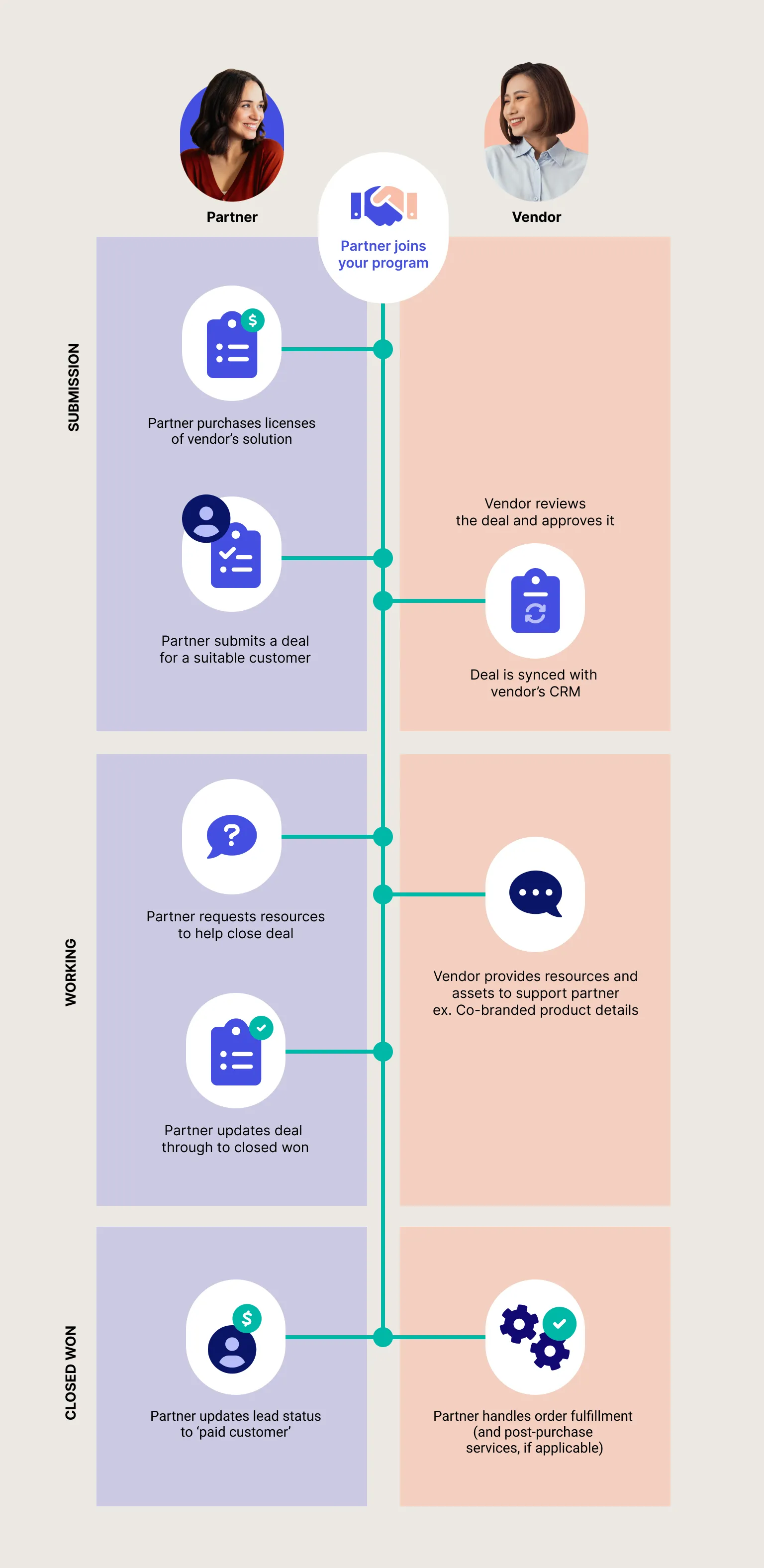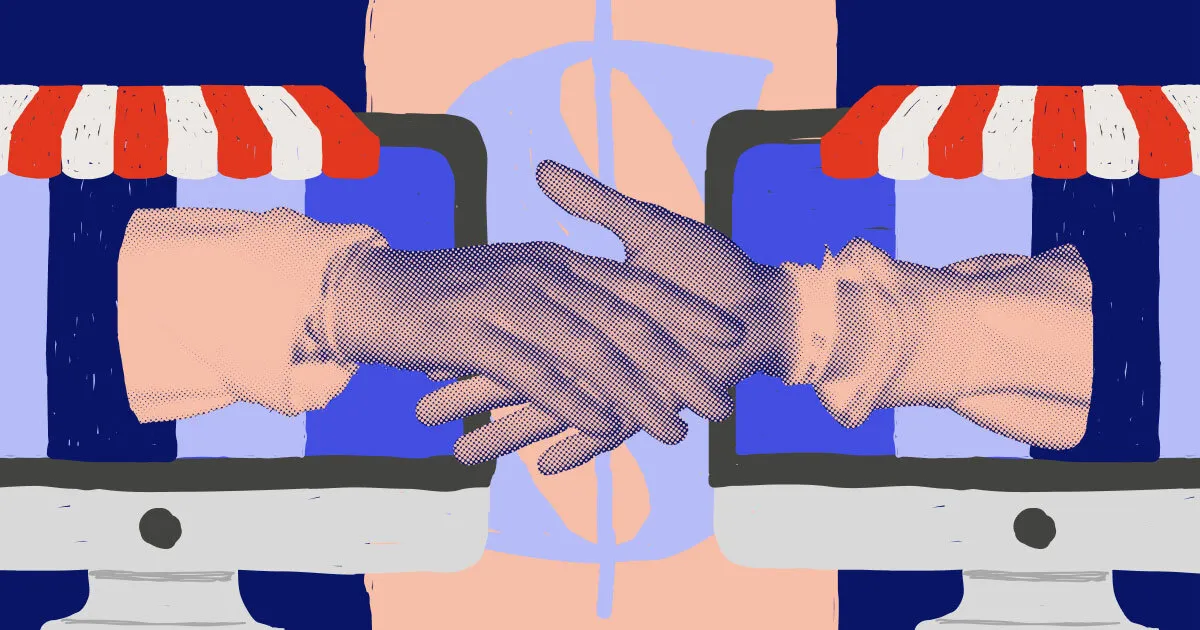SaaS companies invest in partnerships to achieve two main things:
- Adapt to shifting B2B SaaS buying behaviours
Buyers are increasingly looking to third parties (partners) to inform their decisions — working with partners allows you to reach those buyers.
- Do #1 while effectively scaling their go-to-market teams
Partners are compensated on commission or margin, and acquisition doesn’t require the same cost it takes to grow a sales team.
Previously in our Path to SaaS Channel Readiness series, we've looked at how SaaS companies can launch and scale multiple revenue-generating partner programs, starting with affiliate and referral programs.
In this final part, we'll cover how you can use what you've learned from your affiliate and referral partnerships to launch a reseller partner program, which will empower partners to sell your software directly to high-value customers.
The spectrum of reseller partners
When we take a look at the spectrum of partners that fall into the reseller category, it’s helpful to come back to one of the tenets of partnerships: each partner program should work as an extension of your existing internal teams. Generally, resellers are an extension of your sales team, but each type of reseller has a different scope of work and extends different functions of your sales team. Some reseller relationships might even evolve as you grow and move through the Pinnacle Program.
As you begin towards distribution, you are able to work with resellers earlier through the Pinnacle Program by managing order fulfillment and establishing a commission-based reseller relationship with most reseller types (ie. consultants, agencies, VARs, MSPs, ISVs, SIs.) Once you are listed on the Cloud Blue Marketplace and are ready to work with distributors, you will then be able to offer these resellers the ability to handle order fulfillment and start working with you on a margin-based compensation structure.
For example, you can start a partnership with a VAR (value-added reseller) wherein they are the main drivers of deals they bring in, they push the deal through their pipeline and deliver a modified version of the solution to the client but still bring you in when closing the deal. This is necessary because they aren’t able to handle order fulfillment if you haven’t fully set up your distribution system. In this relationship, they are compensated on a commission-based structure.
Once you do have your distribution system set up, you are then able to suggest that the relationship become a vendor-distributor type, wherein the VAR is able to handle order fulfillment and gets compensated on margin-based structure instead (step 2).
This 2 step process can be applied to all the following reseller types. We’ll dig into this process more in a later section of this article. First, let’s take a look at the spectrum of resellers from least involved after the sale to most involved. This is a useful way of categorizing resellers because it suggests the level of support and enablement they need from you to succeed – from least to most.
- Consultants: Consultants are professionals who are trained to evaluate and advise a client in order to help the client make strategic decisions. An HR consultant might be a good reseller for a SaaS payroll solution because they would be able to include that solution in their client recommendations.
- Agencies: Organization or firms to whom companies outsource business functions, campaigns, or services. For example, outsourcing your marketing efforts through a marketing agency. A digital marketing agency might be a good reseller partner for a web hosting solution.
- Independent software vendor (ISV): ISVs resell software products with additional/modified functionality they are able to integrate into the base software solution. Their expertise enables them to optimize each client’s solution to meet their unique goals. Strategically partnering with ISVs can allow you to provide more value to your customers and meet their different needs more closely.
- System integrators (SI): System integrators are akin to tech stack consultants. They audit, recommend, and often optimize a client’s software systems and how they integrate with each other. For instance, an SI who specializes in project management systems and processes might be a good reseller partner for a productivity software solution.
- Value-added resellers: Value-added Resellers are resellers that provide a client value beyond order fulfillment. This can include IT services or professional services like consulting, design, implementation, and training services that complement the solution. Partnering with VARs can be a great way a SaaS company can accommodate complex IT projects customers might need to accomplish that their in-house resources don’t have the bandwidth to take on. Much like SIs, the industry-specific expertise VARs can offer provides the customer with support and resources that have the proper contextual technical or regulatory knowledge that might be necessary to implement a custom solution.
- Managed service providers: Managed service providers work with clients on a longer term basis than value-added resellers. They manage a customer’s IT infrastructure and software systems, typically on an on-going subscription basis. They may also integrate their own native services to other software solutions.
The one-two step of working with reseller partners
Resellers are the most complicated partners to work with, and for good reason! They give you access to a relatively limited but highly qualified audience. This is why they often require more support and enablement resources. This key point is the main reason we built the Partnerships Pyramid framework, a path that sets you up to work with resellers and distributors.

Having developed and refined simplified resources for your affiliates and referrals, by the time you’re ready to partner with resellers, you’ve got resources and processes that have been iterated on at least twice.
As you begin to work with more demanding and involved partners, you are able to take those resources and polish them up to the standard they need to be in, as opposed to going through the initial trial and error process with highly valuable partners.
The Partnerships Pyramid establishes all the processes, resources, and tools you need to work with distributors through marketplaces like Ingram Micro Cloud. By joining The Pinnacle program, you are able to break this last step down even further, into two more manageable steps with the guidance both team’s (PartnerStack and Ingram Micro Cloud) partnerships experts can offer.
The program does this by preparing you to partner with resellers in a way that requires much less initial investment. Think of it as a stepping stone before diving into distribution, your ultimate goal.
Step 1: Prepare for distribution
Step one allows you to establish key relationships early on, without requiring VARs, MSPs, and other resellers to invest heavily in your solution and become distributors right off the bat through PartnerStack. It might be useful to think of these partners not as resellers, but as really involved referrers. In that, they push the deal through the pipe as a reseller would up until order fulfillment, which you as the vendor, will still handle.
At this step, you’re partnering with commission-based resellers who can get a deal to the last step — but you still have to finish the sales process.
You’ll use the resources, processes, and insights to pull from your existing affiliate and/or reseller programs to inform your approach.
Main objectives:
- Develop relationships with early top-performing resellers
- Refine reseller support and enablement resources for partner teams
- Track and optimize reseller performance
- Support provisioning of distribution system/listing with Ingram Micro Cloud
Step 2: Operationalize distribution
Before you know it, you’re ready for step two: distribution with Ingram Micro on the Cloud Blue Marketplace. By then, you’ve solidified trust between you and your partners and have worked together to refine your reseller processes. At this stage, you’re able to work with margin-based resellers who purchase product licenses from you and fulfill customer orders on their own. (aka distribution!) Your product is distributed to partners through the Ingram Micro Cloud Blue Marketplace and other marketplaces.
Main objectives:
- Onboard new and existing partners as distributors
- Refine your reseller/distributor ideal partner profile (IPP)
- Grow your partner team to support larger resellers
- Build out partner to partner pipeline
How do resellers drive revenue?
As we mentioned previously, your relationship with different resellers will evolve as you establish your distribution system. A large part of that is the mechanisms of your revenue streams and the workflows that enable you to pay-out your partners.
This is what the workflow will look like wherein you cannot yet accommodate distribution and you handle order fulfillment (step 1):
- Partner application is approved.
- Partner finds a suitable customer for your product.
- Partner registers the deal through their partner dashboard and initiates a deal for this customer.
- Vendor’s partner team is notified of the form submission
*If a CRM has been integrated, the deal, its details, and its stage are synced bi-directionally. - Partner may request support from the vendor (eg. dedicated partner manager to co-sell with).
- Partner updates deal stage through to close won.
- Partner maintains ongoing visibility into deal status through to ‘paid’ customer.
- Vendor approves the deal once marked close won and paid customer.
- Partner is paid a portion of the sale through PartnerStack.

This is what the workflow will look like once you can accommodate distribution and your partners can handle order fulfillment (step 2):
- Partner distribution application is approved.
- Partner purchases licenses of vendor’s solution.
- Partner finds a suitable customer for your product.
Partner submits a deal registration form with prospect’s details and initial deal stage. - Vendor is notified of the form submission.
*If a CRM has been integrated, the deal, its details, and its stage are synced bi-directionally throughout the following steps. - Reseller may request support from the vendor (eg. dedicated partner manager to co-sell with).
- Reseller updates deal stage through to close won.
- Reseller updates lead status to ‘paid customer’.
- Partner handles order fulfillment and post-purchase service (if applicable).

How do you recruit resellers?
Much like your affiliate and referral partner acquisition strategy, some lower lift tactics include taking advantage of existing channels like your website footer, social media channels, and email campaigns. You can also find value in using a third-party partner recruitment provider like Grovia.
However, because of the nature of reseller partners, these tactics will be less effective in recruiting them compared to when used to acquire affiliates and referral partners, who don’t require a deeper knowledge of your ICP or solution to effectively resell it.
A great thing about approaching channel readiness through the pyramid framework is that you are able to benefit from the partner relationships your affiliate and referral programs have fostered. A good way to take advantage of your previous success is picking out top-performing referral partners that can potentially become successful resellers. Some referral partners will have a deeper understanding of your solution, allowing them to better qualify their referrals.
Another way to take advantage of the success of your existing programs is identifying your super users, some of whom might be managing accounts on behalf of your customers. Moreover, you can tap freelancers, professionals, and maybe even agencies that have first-hand experience using your product. These users not only present perfect reseller partnership opportunities, but may help you refine your Ideal Partner Profile for your reseller program.
Again, because reseller and distribution partnerships are one of the most complex partnership structures, prospecting is arguably a powerful tactic you can use for partner acquisition whether that entails strategically targeting professional communities or attending conferences and other industry events. A more involved strategy is needed when building relationships with resellers and distributors.
Enabling resellers with your partner team
As you begin to accommodate resellers, you will notice the more and more pressing need to grow your partnerships team to provide these resellers with the support and resources they need to succeed.
A huge part of running a successful reseller program is the ability to coordinate and enable bigger partners. Because of the level of involvement and investment resellers have in pushing a deal through the pipe, they oftentimes have different people on their teams with more specialized roles, as opposed to a referral or affiliate partner who wears many hats. Larger resellers can consist of large independent sales teams. It’s common for a reseller or distributor to include 50-100 sales representatives. This is a key difference between managing a reseller program and an affiliate or referral one. The lift is bigger as you work with the larger partners in this space. But you can rest assured that the massive opportunity resellers and distributors offer is worth more than the cost of putting together a capable partnerships team for your program.
Growing your team through specialized roles will ensure your partners are well equipped and confident to resell your products. Here are the basic partner team personas you should aim to grow your team with:
- Enablement/marketing persona: These folks are in charge of creating and disseminating enablement and marketing materials to your partners. They would also be the point of contact for any co-marketing initiatives like joint webinars and sponsored events. You want to make sure you are providing them with the tools to explore those opportunities and enable different partners’ needs.
- Sales persona AKA sales representatives’ dedicated partner manager: Sometimes known as a dedicated partner manager, this team member is in charge of sales enablement like co-selling support. Formalizing the process for scheduling calls and offering guidance to your partners should be a priority. Again, some of these resellers are going to have upwards of 50 sales representatives, so streamlining the process and making sure you have the bandwidth and resources to support multiple deals will be essential.
- Portal management/operations persona: This team member is in charge of data migration, integrations, data cleanliness, and partner performance analytics - anything to do with the upkeep of the partner portal. They need to be equipped with the right training and resources to monitor and organize their partner portal instance. Connecting them with your platform’s support avenues, whether that is a well-organized set of help docs and/or a dedicated support manager should be an early priority. This ensures they have the skills and visibility to find optimization opportunities as they report on partner performance and processes.
- Finance persona: This team member is responsible for managing rewards that get paid out each month. It’s important that they are able to access the details of every deal and evaluate its accuracy and completeness, confirming or flagging them. Providing them with the proper training and access will help limit the time you spend each month reconciling payments.
It’s important to remember that this is just a rough, very generalized outline of the different functions you might need in your partner team. You might not need to recruit for each role off the bat. As you find out the gaps and opportunities your partner program has, the need for more team members will become evident.
Working with resellers and distributors doesn’t have to be an overwhelming daunting endeavor. As with everything else in life, breaking down a big objective into smaller, manageable chunks makes it infinitely more achievable. Ultimately, this is what The Pinnacle Program hopes to provide — the manageable pathway and the right guidance you need on your partnerships journey towards distribution.

















